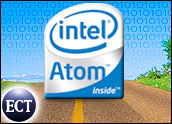
Intel announced on Thursday new processors built around its plans for a new category of highly integrated, purpose-built and Web-savvy system-on-chip (SoC) designs.
The company also unveiled its first eight products under its Intel EP80579 Integrated Processor family for security, storage, communications and industrial robotics.
Intel is basing several of these SoC chip designs on the same blueprints as the company’s existing processors that run much of the Internet, called “Intel architecture” (IA), according to company officials. The products are aimed at offering new levels of performance and energy efficiency compared to traditional SoCs, combining multiple functions onto one chip, and will be customized to target the company’s traditional computing businesses and several growth areas across the consumer electronics (CE), mobile Internet device (MID) and embedded markets.
“The Internet phenomenon is undergoing rapid and massive transitions. By 2012, we expect the broad use of the Internet to reach 1.4 billion new subscribers,” said Gadi Singer, vice president for the mobility group and general manager of the SoC enabling group for Intel.
Product Delivery
Intel has more than 15 SoC projects planned internally, including its first such consumer electronics chip, codenamed “Canmore,” scheduled for introduction later this year. The second-generation Sodaville is planned for release next year. In addition, Intel’s second-generation embedded product line is scheduled to arrive in 2009, with its next-generation platform for MIDs, code-named “Moorestown” (featuring Lincroft) scheduled for release by 2010.
Many of these new products will be based on the Intel Atom processor core. All of these chips are designed to provide increased performance and energy efficiency along with the ability for customization.
Intel anticipates faster development schedules and time-to-market delivery.
“We’re now able to deliver more highly integrated products ranging from industrial robotics and in-car infotainment systems to set-top boxes, MIDs and other devices,” said Singer.
Embedded Computing
Four of the eight new SoC Intel EP80579 products include Intel’s QuickAssist Technology, meant to simplify the use and deployment of security and packet accelerators in Intel-based computers. Each SoC is based on the Intel Pentium M processor, integrated memory controller hub and a variety of integrated communications and embedded I/O (input/output) controllers.
These products come in a range of speeds, power dissipation levels and commercial/industrial temperature options. In some cases, they will lead to platforms that have a 45 percent smaller board footprint and 34 percent lower power dissipation, Singer said.
Opportunity for Growth
Intel’s new chip platform is aimed to address the rapid expansion of the Internet. The number of Internet-connected devices is reaching into the billions. This is causing performance expectations to rise and device sizes to shrink, said Doug Davis, vice president of Intel’s digital enterprise group and general manager of its embedded and communications group.
“Emerging classes of computers either exist or are being developed. The common factor is that they all will be connecting to the Internet and will need to share data,” Davis said.
Product Highlights
The smart SoC versions with Intel QuickAssist Technology accelerate cryptographic and packet processing for security appliances. These include virtual private network (VPN) gateways, firewalls, unified threat management (UTM) and enterprise voice applications such as Voice over Internet Protocol (VoIP) and converged access platforms.
The Intel EP80579 Software for Security Applications on Intel QuickAssist Technology provides tools for developing security appliances. The Intel EP80579 Software for IP telephony applications on QuickAssist Technology provides libraries for secure enterprise voice applications.
Intel already has 50 customers for these products, some using them for nearly a year. A variety of initial systems will arrive this quarter, with more expected later this year and next, as embedded system design cycles can take 12 to 18 months to get into the marketplace, said Davis.
What It Is
Intel’s EP80579 Integrated Processor Product Line combines four separate chip processes onto one processor. These processes are the IA Instruction Set, the memory controller, the I/O controller and the Quick Assist technology.
The result, according to Intel, is a four-way gain. The new chip uses lower power and has a smaller footprint. It also provides comprehensive I/O and integrated acceleration.
Powered by the Atom
The Atom Processor Core Intel announced will usher in the company’s new strategy for enhancing computing power.
It provides a low-power IA processor with a ground-up new IA architecture design for low-power operation. In the future, the Atom processor will powering Intel’s next generation of SoCs.




















































